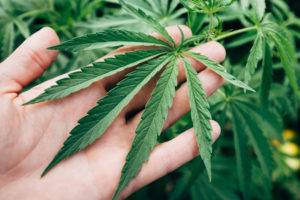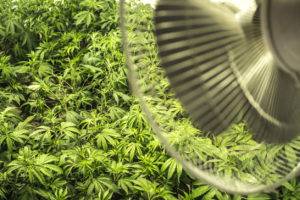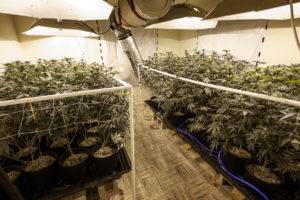
Growing hemp indoors puts you in complete charge of variables that are usually left to Mother Nature. Having that control removes some of the guesswork from indoor cultivation, but it’s also a persistent and sometimes complex responsibility to take on as you seek to manage hydration, light, nutrients, and pests/disease.
In the fall of 2021, my blog entitled Successful Indoor Hemp Growing focused on the basic inputs needed at each stage of hemp growth – seed selection, seed starting, vegetative phase, and flowering phase. This year, as our indoor growers start gearing up for the winter season, I’m going a little more in depth on some infrastructure basics that play a role in successful indoor production.

Just How Resilient is Hemp?
Hemp has been cultivated globally for hundreds of years, especially for its highly functional fiber. It’s known to be a hardy plant, able to withstand some of the extremes that occur in agricultural production. Yet when it comes to growing the hemp indoors, these cultivars can take on a whole new personality and become a bit pickier about inputs. It’s not difficult to manage those inputs correctly, but it does take a different level of time and attention than cultivating hemp as a row crop in the field. Regular monitoring and having the right infrastructure are essential. Please note that for the purposes of this article, I’m going to focus specifically on indoor growing as opposed to greenhouse growing.

Hydration
Humidity and direct watering are two means that hemp uses to achieve the necessary hydration for growth and maximum vigor. Let’s talk about humidity first. If you have an unventilated grow room, you are committing to humidity management that would ordinarily be left to outdoor conditions. Inside, humidity becoes a function of the environmental controls you have in place. It’s common for there to be a general dampness in a grow room arising from watering or irrigating your plants in a closed environment as well as plant respiration during growing hours. Excessively high humidity creates a paradise for pests and pathogens, especially molds, so if you are seeing condensation anywhere, getting that moisture under control should be a top priority for the health of your plants. An efficient way to tackle this is in addition to air conditioning is with a dedicated dehumidifier specifically designed for indoor grows. This makes it possible for you to dial in a healthy humidity level more precisely with the stand-alone dehumidifier and use your HVAC thermostat to control the temperature: each system gets to perform the job it was engineered to do best! In Colorado we like the humidity around 50% but it varies by region. Maintain your HVAC with routine and frequent checkups by a trained professional. They can help you fine tune your system for optimal temperature control. Temperature control is important, but not as impactful for hemp as humidity.
Just as you manage the level of humidity in the air, there are steps you can take to help ensure that your watering system is healthy and well-calibrated. Aside from correct levels of nutrients and pH, there are other factors in play that can impact how effectively you are delivering water to your plants. The physical integrity of your irrigation system is an obvious place to start your analysis. Things like compromised filters, badly fitted pipes, or faulty drips may show up in the form of leaks and puddles – your warning signal that something is amiss. Another signal to watch for is plants that appear to be dehydrated, indicating a possible blockage in the irrigation line. There is always potential for a component to fail somewhere, so regular end-to-end visual inspections of your irrigation arrangement is an important to-do for your healthy grow.

Air Flow
In the open air, the environment of the hemp row crop is moving, changing, and refreshing constantly as air flows across the field. Even on still, high humidity days, there will be some movement of air around the plant. Hour-to-hour, day-to-day, and month-to-month, that air will contain varying degrees of moisture and the currents of air will vary in velocity. This natural fluctuation is easily tolerated by hemp plants – barring severe extremes. Indoors, however, it’s a whole different ball game. Hemp requires a fresh air supply to thrive, so it’s up to us to make sure our grows have great air circulation. Essentially this means we want a setup where the fresh air is coming in, moving through the plants, and expelled gases are exhausted out again. Just like human beings, plants breathe …or at least they perform an exchange of gases through photosynthesis. In fact, it has been estimated that hemp breathes in four times more CO2 than trees, making it a carbon negative crop! By establishing a good air circulation system, you’re making sure that your plants are not stuck breathing in the oxygen they’ve just breathed out. Good systems feature air movement, ventilation, tight seals around external-facing vents, windows, and doors, and high-quality air intake filters that remove harmful microorganisms or pollutants such as smoke. A clean, fresh supply of air also inhibits pest infestations and the spread of molds!

Lights
Regulating light exposure is easy. Timers can be used to make sure that lights go off and on at prescribed intervals. These intervals should be driven by the lifestage of the plants. For example, during the vegetative phase (30-60 days), hemp needs 18-24 hours of light per day however, when it begins to flower, it needs a full 12 hours of darkness. If you re-read my November 2021 blog, I’ve included some guidelines for just how much light is needed at each phase of plant maturity. In addition to duration, light quality needs to be considered. Lights in a hemp grow need to deliver the full spectrum of light waves, just like the sun. Using regular household bulbs or tubes will leave your plants lacking essential light waves needed for effective photosynthesis. Like any other systems, lighting needs to be monitored regularly – but not just for duration! Some indoor grow lights can emanate significant heat. Too much of that heat can result in an ambient temperature that is too high around the plant, reducing its vigor and ability to grow. Additionally, a too-bright or too-close light source can scald leaves.
Safety
HVAC, dehumidifiers, fans, irrigation systems, lighting … folks, these are all electrical components and that means we need to be super serious and intentional about how we put them in play and maintain them. An electrical fire in your grow room is a price you do NOT want to pay. Over our careers, we’ve seen the full range of risky setups … things like extension cords resting on a wet floor or irrigation filters dangerously clogged or water pumps connected to nearly dry reservoirs. These are all potential fire hazards, but they also are – as you’d imagine – easily avoidable safety threats. We urge that you honestly appraise your electrical knowledge and call in a specialist when necessary to make sure your indoor grow is safely set up. Yes, that costs money, but not nearly as much as replacing your entire home should it burn to the ground! When in doubt, call in a licensed electrician or HVAC expert to help you ensure that your systems are optimal and that you fully understand your role in ongoing maintenance of those systems. A maintenance roster and checklist can be a wonderful thing!


Recent Comments